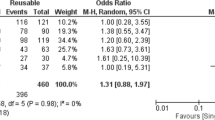Abstract
Maintenance of flexible ureteroscopes can involve high costs and administrative burden. Instrument fragility necessitates eventual repair, rendering scopes inaccessible during refurbishment. We conducted a multi-institutional prospective cohort study to identify perioperative factors influencing flexible ureteroscope durability. Patients undergoing flexible ureteroscopy (URS) at six United States endourology centers were enrolled between August 2014 and June 2015. Surgeon self-reported concern and satisfaction with scope performance as well as upward and downward angles of deflection for each scope tip were measured before and after each procedure. The need for scope repair was determined by the operating surgeon at the time of the procedure and recorded. 424 URS cases using 74 flexible ureteroscopes were identified. Scope repair was required in 28 cases (6.6%) involving 26 scopes (35.1%). Upon univariate analysis, shorter patient height, absence of guidewire use, presence of a ureteral access sheath (UAS), longer procedure time, larger stone size, lithotrite type, surgeon training level, and self-reported concern were associated with scope repair. Upon multivariate analysis, UAS use (OR = 2.53, p = 0.005) and degree loss of scope upward flexion during a case (OR = 1.02, p = 0.03) increased the odds of a scope needing repair while the use of safety guidewire decreased the odds of a scope repair (OR = 0.50, p = 0.045). Lithotrite use and surgeon concern were associated with degree loss of scope upward flexion. The use of a UAS, absence of a safety guidewire, and the loss of upward ureteroscope flexion should be considered when evaluating means of optimizing reusable ureteroscope durability.

Similar content being viewed by others
References
Marshall V (1964) Fiber optics in urology. J Urol 91:110–114
de la Rosette J, Denstedt J, Geavlete P et al (2014) The clinical research office of the endourological society ureteroscopy global study: indications, complications, and outcomes in 11,885 patients. J Endourol 28:131–139
Tosoian JJ, Ludwig W, Sopko N, Mullins JK, Matlaga BR (2015) The effect of repair costs on the profitability of a ureteroscopy program. J Endourol 29:406–409
Kramolowsky E, McDowell Z, Moore B, Booth B, Wood N (2016) Cost analysis of flexible ureteroscope repairs: evaluation of 655 procedures in a community-based practice. J Endourol 30:254–256
Semins MJ, George S, Allaf ME, Matlaga BR (2009) Ureteroscope cleaning and sterilization by the urology operating room team: the effect on repair costs. J Endourol 23:903–905
Shah K, Monga M, Knudsen B (2015) Prospective randomized trial comparing 2 flexible digital ureteroscopes: ACMI/Olympus invisio DUR-D and olympus URF-V. Urology 85:1267–1271
Karaolides T, Bach C, Kachrilas S, Goyal A, Masood J, Buchholz N (2013) Improving the durability of digital flexible ureteroscopes. Urology 81:717–722
Knudsen B, Miyaoka R, Shah K et al (2010) Durability of the next-generation flexible fiberoptic ureteroscopes: a randomized prospective multi-institutional clinical trial. Urology 75:534–538
Monga M, Best S, Venkatesh R et al (2006) Durability of flexible ureteroscopes: a randomized, prospective study. J Urol 176:137–141
Carey RI, Martin CJ, Knego JR (2014) Prospective evaluation of refurbished flexible ureteroscope durability seen in a large public tertiary care center with multiple surgeons. Urology 84:42–45
Harris PA, Taylor R, Thielke R, Payne J, Gonzalez N, Conde JG (2009) Research electronic data capture (REDCap)–a metadata-driven methodology and workflow process for providing translational research informatics support. J Biomed Inform 42:377–381
Kanda Y (2013) Investigation of the freely available easy-to-use software “EZR” for medical statistics. Bone Marrow Transplant 48:452–458
Ghani KR, Wolf JS (2015) What is the stone-free rate following flexible ureteroscopy for kidney stones? Nat Rev Urol 12:281–288
Afane JS, Olweny EO, Bercowsky E et al (2000) Flexible ureteroscopes: a single center evaluation of the durability and function of the new endoscopes smaller than 9Fr. J Urol 164:1164–1168
Multescu R, Geavlete B, Georgescu D, Geavlete P (2014) Improved durability of Flex-Xc digital flexible ureteroscope: how long can you expect it to last? Urology 84:32–35
Canales BK, Gleason JM, Hicks N, Monga M (2007) Independent analysis of olympus flexible ureteroscope repairs. Urology 70:11–15
Kaplan AG, Lipkin ME, Scales CD, Preminger GM (2015) Use of ureteral access sheaths in ureteroscopy. Nat Rev Urol 13:135–140
Breda A, Territo A, López-Martínez JM (2016) Benefits and risks of ureteral access sheaths for retrograde renal access. Curr Opin Urol 26:70–75
Pietrow PK, Auge BK, Delvecchio FC et al (2002) Techniques to maximize flexible ureteroscope longevity. Urology 60:784–788
Dutta R, Vyas A, Landman J, Clayman RV (2016) Death of the safety guidewire. J Endourol 30:941–944
Acknowledgements
This work was supported by the educational grant from the Boston Scientific Foundation (TC), the US National Institutes of Health with grants K12-DK-07-006 (TC), and P20-DK-100863 (MLS, TC). This material is also the result of work supported by resources from the Veterans Affairs Puget Sound Health Care System, Seattle, Washington. The sponsors played no direct role in the study.
Author information
Authors and Affiliations
Corresponding author
Ethics declarations
Funding
This study was funded by the educational grant from the Boston Scientific Foundation, the US National Institutes of Health with grants K12-DK-07-006, and P20-DK-100863.
Conflict of interest
Marshall L. Stoller and Thomas Chi serve as paid speakers and consultants for Boston Scientific Corporation and have received educational grant funding from Richard Wolf. Marshall L. Stoller has served as a paid speaker for the Karl Storz Company.
Ethnical approval
All procedures performed in studies involving human participants were in accordance with the ethical standards of each institutional research committee and with the 1964 Helsinki Declaration and its later amendments or comparable ethical standards.
Informed consent
Informed consent was obtained from all individual participants included in the study.
Rights and permissions
About this article
Cite this article
Taguchi, K., Harper, J.D., Stoller, M.L. et al. Identifying factors associated with need for flexible ureteroscope repair: a Western Endourology STone (WEST) research consortium prospective cohort study. Urolithiasis 46, 559–566 (2018). https://doi.org/10.1007/s00240-017-1013-y
Received:
Accepted:
Published:
Issue Date:
DOI: https://doi.org/10.1007/s00240-017-1013-y




